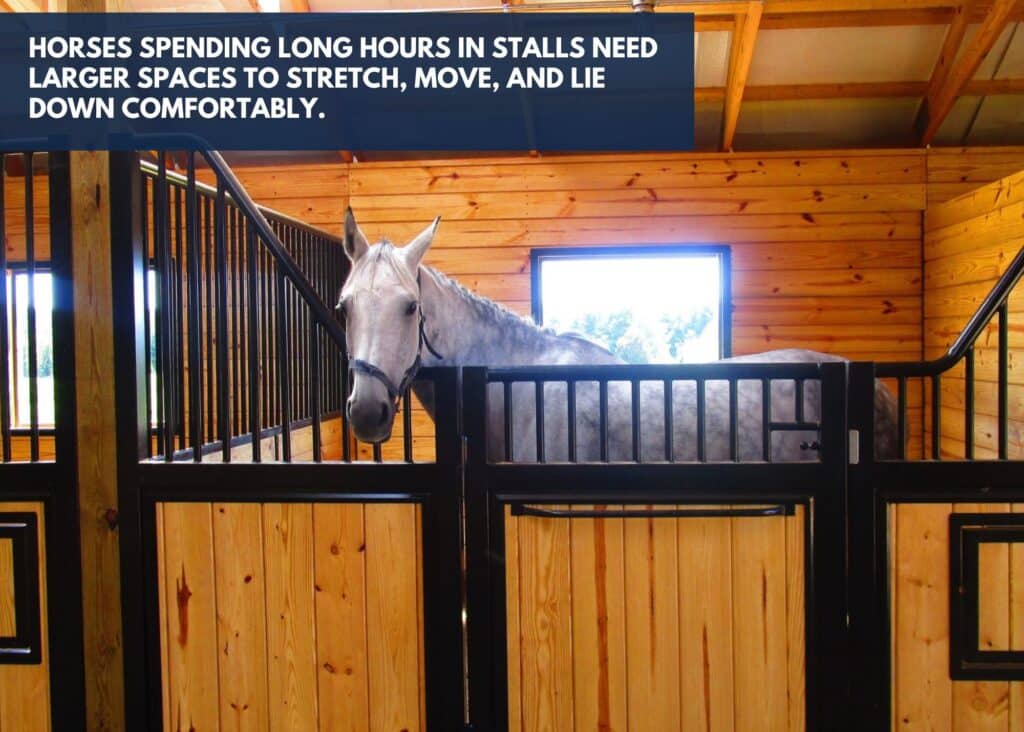We all want to provide the best possible care for our horses. Often, even the smallest details significantly impact their health and happiness.
Many horse owners find themselves puzzling over the optimal stall size. After all, creating a space that is too small can lead to discomfort. At the same time, one that’s excessively large might go underutilized. You want to know that your horse is comfortable, healthy, and content, no matter where they are housed.
This blog post will explore the importance of proper horse stall sizing, look into the key factors affecting stall size, and offer some design tips to enhance your stall layout.
At Sunset Valley Metalcraft, we have been serving the horse enthusiast industry for almost 50 years. Our expertise in horse care and stable management ensures we provide you with the most accurate and helpful information.
Ready to learn more? Let’s learn how to create the perfect environment for your equine companion.
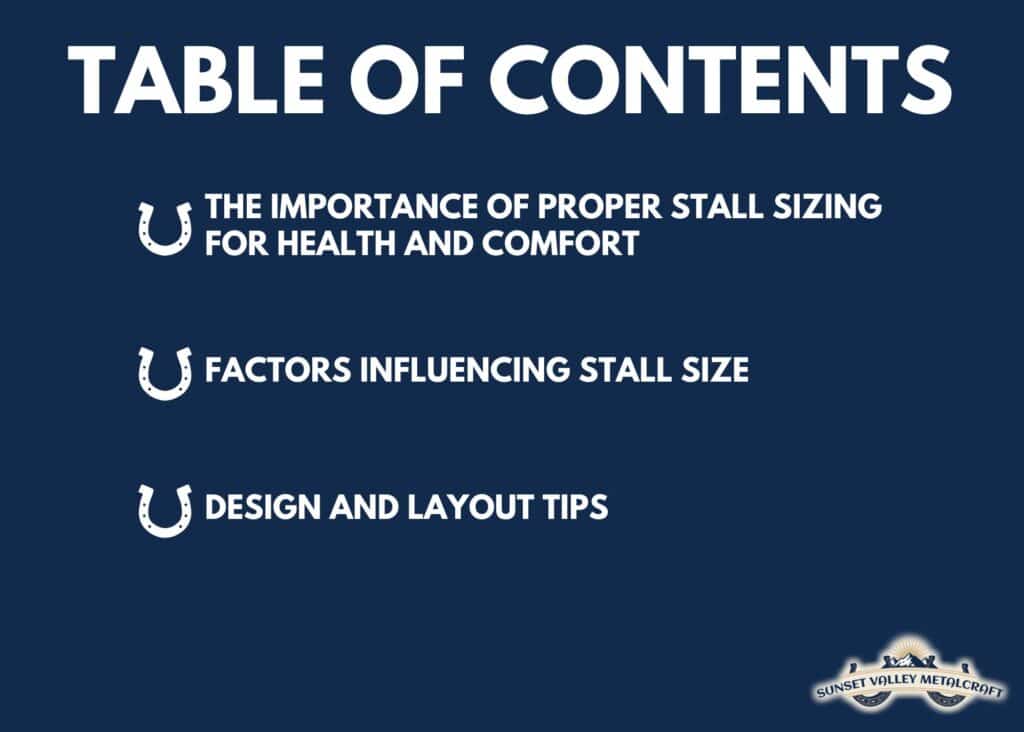
The Importance of Proper Stall Sizing for Health and Comfort
Why does stall size matter so much for your horse?
Like all living creatures, horses have basic needs that must be met to ensure a comfortable and healthy existence. These include sufficient freedom of movement, adequate ventilation, and a secure, safe environment. Proper stall sizing directly impacts the fulfillment of these needs. Understanding these basic needs is the first step in creating the perfect stall for your horse.
The living space of a horse has significant implications for its health and behavior. Environments that are too cramped can lead to physical health issues and exacerbate poor behavior. Wider spaces encourage relaxation and freedom of movement, allowing horses to engage naturally in behaviors like lying down and rolling. This contributes to a calmer, happier, and more contented animal.
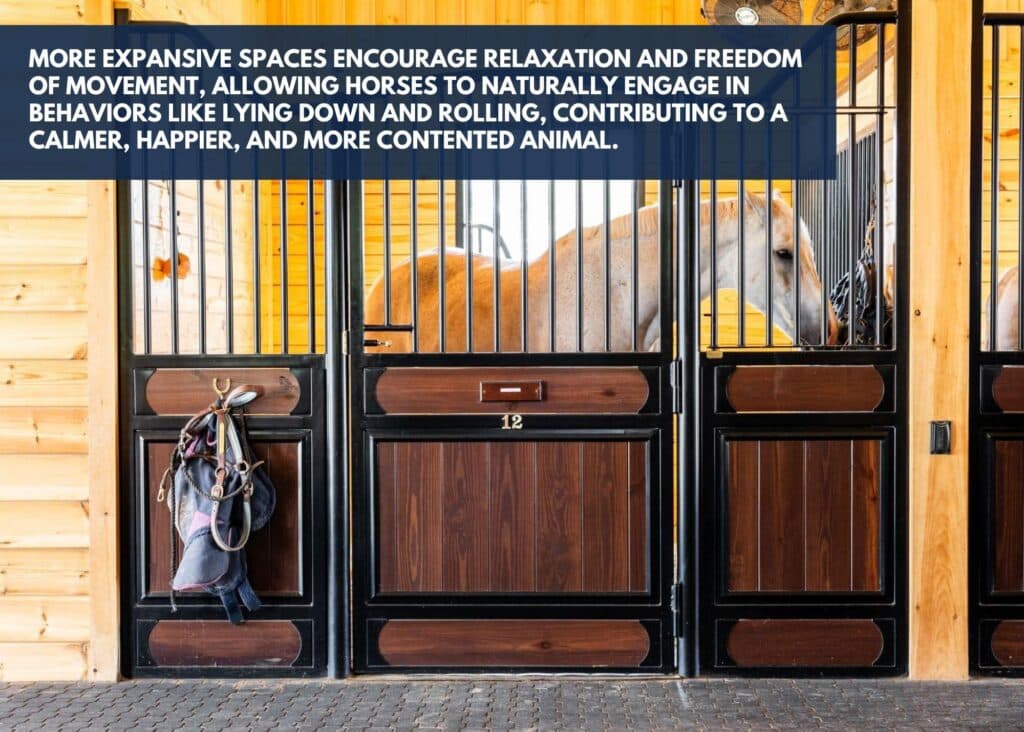
Proper sizing is crucial because:
- It Minimizes Stress: Horses confined in spaces too small can become stressed, leading to unwanted behaviors and impacting their mental wellness. Stress from overcrowding or confinement can manifest as digestive issues, weakened immunity, and even lameness. Behaviorally, cramped quarters can trigger anxiety, aggression, and stereotypies such as cribbing or weaving.
- It Protects Physical Health: Sufficient space helps prevent injuries and prevents joint stiffness. A horse must be able to move comfortably to facilitate proper circulation and digestion.
- It Enhances Comfort: Larger stalls give horses the option to lie down and move about unhindered. This promotes better rest and muscle recovery, essential for their overall comfort.
Understanding these fundamentals highlights why stall size can’t be overlooked. For more information, check out our blog post about keeping your horse comfortable and safe.
Now, let’s dive into the factors that should influence your stall size selection.
Factors Influencing Stall Size
1. Horse Size and Breed
One of the primary factors that dictate the appropriate stall size is the breed and size of the horse. Different horse breeds have specific physical attributes that impact their spatial needs.
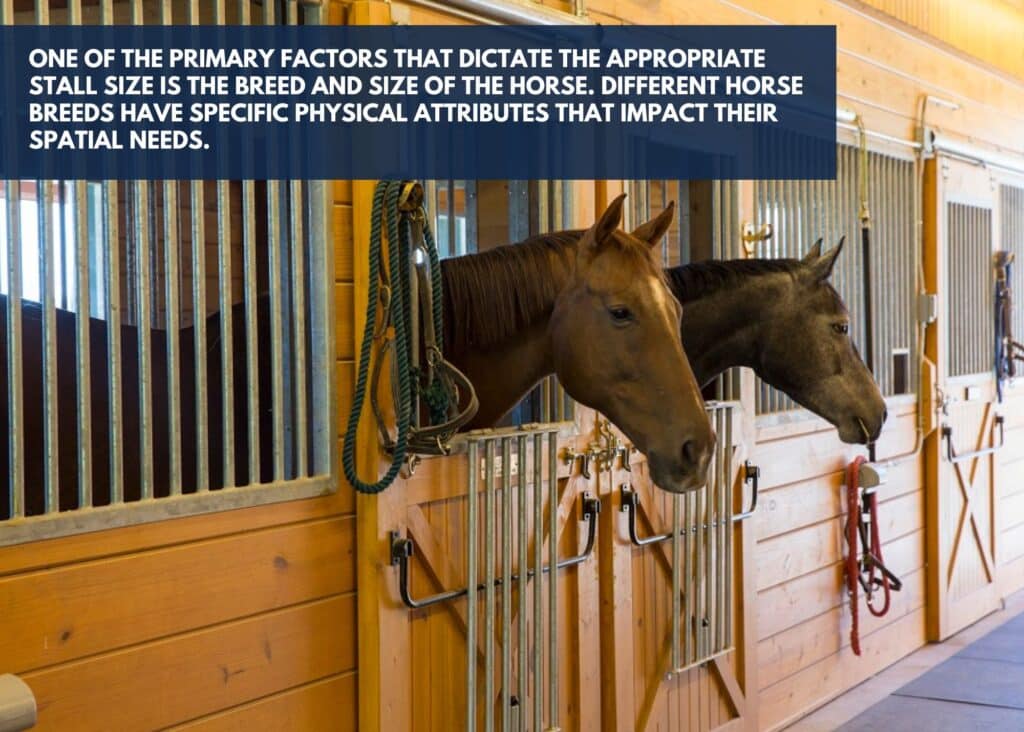
Here’s a quick guide to help you determine appropriate sizing:
- Ponies and Small Breeds (8-14 hands high): Typically require a stall size of about 10×10 feet or slightly larger for more comfortable living. This provides adequate space during rest or activity.
- Average-Sized Horses (15-16 hands high): Need around 12×12 feet stalls to ensure adequate space to move freely, lie down comfortably, and maintain overall well-being.
- Large Breeds and Draft Horses(16-18 hands high): A stall of 12×12 or 12×14 feet is often necessary to accommodate their larger frames. This provides the proper space for these larger horses.
At Sunset Valley, we understand the necessity of adjusting stall size based on horse breed and size. Offering the right stall size ensures that your horse’s physical needs are met, contributing to their overall health and happiness.
2. Horse Activity Level and Behavior
Beyond breed and size, your horse’s activity level and temperament also significantly determine the appropriate stall size.
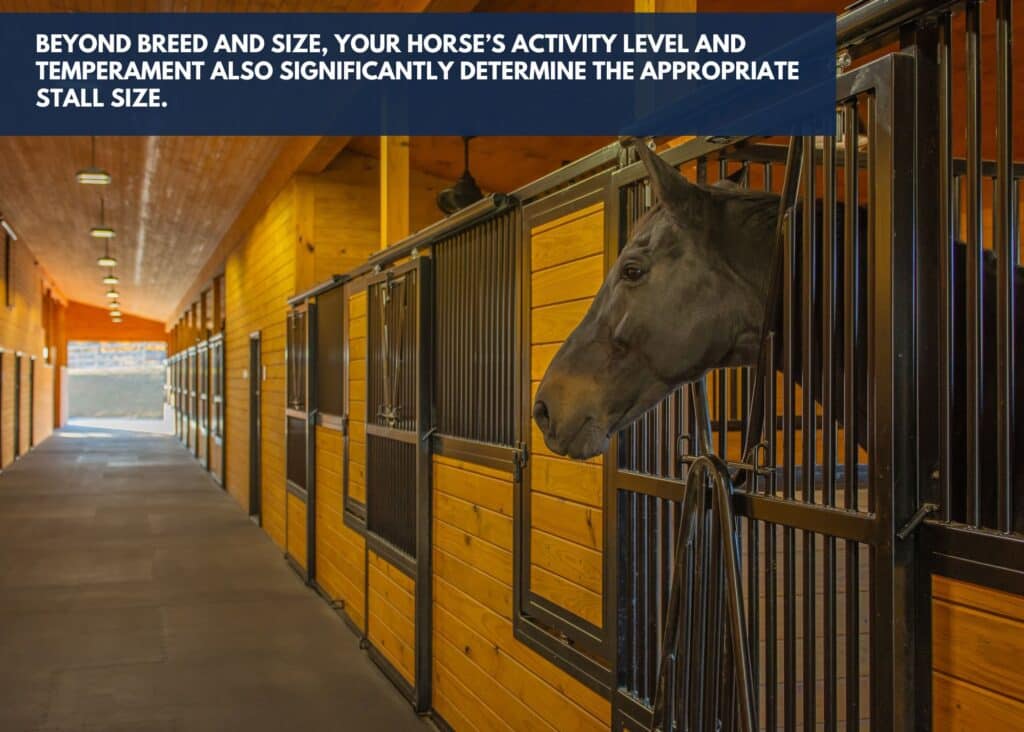
Not all horses have the same activity or behavior levels, which may influence the size of the stall they require.
Consider the following:
- Activity Level
- Space for Movement: Active horses, especially younger or more energetic ones, may require larger stalls to move around comfortably without feeling cramped. This helps prevent restlessness and reduces the risk of stress or injury.
- Exercise Needs: Horses with higher activity levels are more likely to pace or move within their stall. A larger stall can accommodate these movements, promoting better physical health.
- Turnout Limitations: If the horse has limited turnout time, a larger stall can compensate by providing more room to stretch, lie down, or roll.
- Temperament
- Calm vs. Restless Horses: Calm horses may tolerate smaller stalls, while more anxious or high-strung horses benefit from additional space to minimize the stress and prevent injury from accidental collisions with stall walls.
- Social Interactions: Horses with a social temperament may feel more relaxed in larger stalls, especially if they are positioned to see and interact with other horses.
- Stress Management: A larger stall can provide a sense of freedom for nervous or excitable horses, improving their overall mental health and behavior.
Adjusting stall size based on the activity level and behavior is crucial to prevent stress-induced health issues and behavioral problems.
3. Intended Use of the Stall
The way a stall is used also figures prominently in determining its size. There are stark differences between stalls meant for temporary holdings and those designed for long-term housing:
- Temporary Holding Stalls: A smaller stall may work for short periods, such as overnight shelter or temporary event stabling. As these are for short-term stays, they can be on the smaller side, often around 10×10 feet.
- Long-Term Housing Stalls: Horses spending long hours in stalls need larger spaces to stretch, move, and lie down comfortably.
More spacious stalls (12×12 feet or larger) are recommended for horses that reside primarily inside to enhance comfort and health. - Special Needs:
- Mares with Foals: Larger stalls (e.g., foaling stalls) provide space for the mare to deliver and for the foal to move around safely.
- Injured or Recuperating Horses: These horses may require more room to avoid further injury and accommodate medical equipment or caregivers.
Tailoring the stall size to its intended use ensures your horse remains comfortable and healthy while optimizing practicality and functionality.
Design and Layout Tips
Beyond just size, designing the right stall environment enhances its utility and comfort. Here are a few layout strategies to consider:
- Proper Ventilation: Ensures consistent air circulation, which is vital for preventing respiratory issues. Windows or grills allow fresh air without direct drafts. Ridge vents or cupolas help with ventilation while maintaining weather resistance.
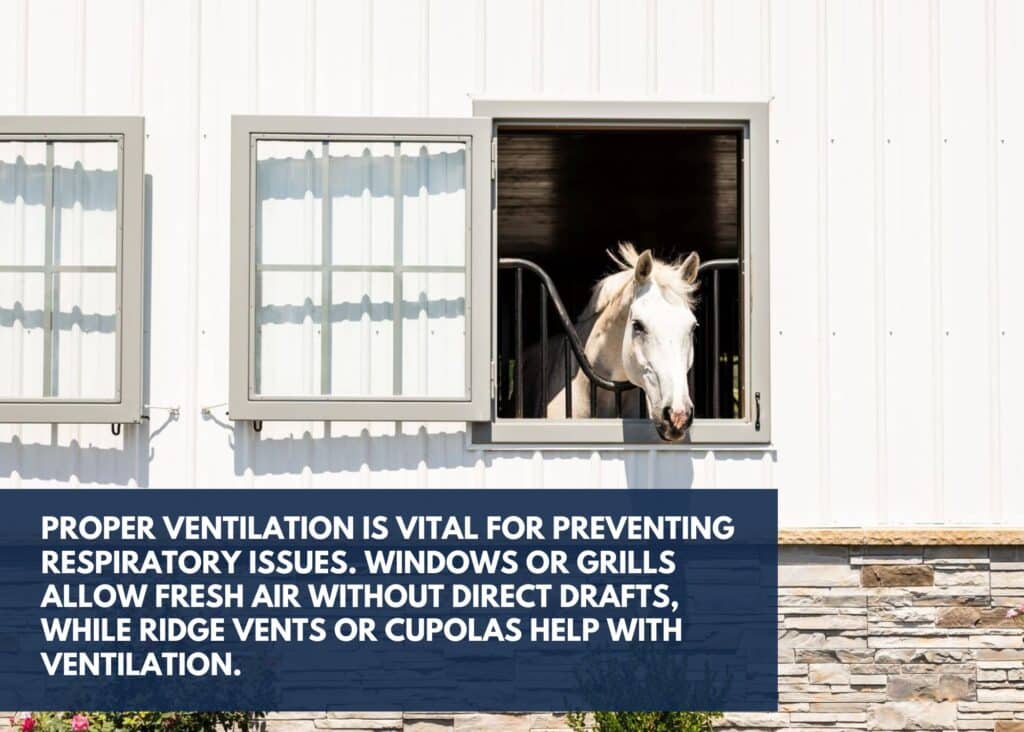
- Stable Flooring: Consider materials that prevent slipping and provide comfort, like rubber mats for durability and ease of cleaning. Include a slight slope for drainage, especially if using stone dust or similar materials.
- Adequate Light: Allows horses to maintain their natural circadian rhythms, promoting better mental health. Incorporate windows or skylights to reduce dependence on artificial lighting. Use LED lights that are bright but not harsh.
- Ease of Maintenance: Design stalls for straightforward cleaning with features like removable sections or sloped flooring for drainage. Use low-maintenance materials that can withstand wear and tear.
Crafting well-thought-out stalls supports a horse’s health and contributes to efficient management and upkeep of the barn as a whole. You can learn more about upgrading your horse stalls by reading our blogs “Upgrading and Personalizing Your Horse Stall” or “A Comprehensive Guide to Crafting Custom Horse Stalls.”
Conclusion
In conclusion, selecting the correct horse stall size, accounting for the horse’s specific needs, and designing a conducive environment are essential steps in ensuring your horse’s health, comfort, and happiness. This creates a sanctuary for your horse and facilitates an environment that caters to their well-being. With this holistic approach, you’re well-equipped to provide the perfect shelter for your equine companion.
If you are ready to create the perfect stall setup, Sunset Valley Metalcraft is here to help. By partnering with us, you gain reliable information and a trusted ally in the pursuit of equestrian excellence.
Visit our Project Gallery to see the kind of work we do or for ideas on designing your horse’s home.
Contact us today for personalized stall sizing solutions and explore our range of horse care equipment. We look forward to hearing from you!


